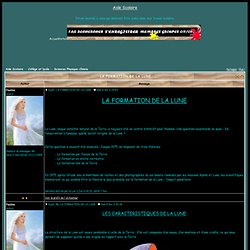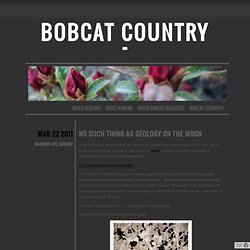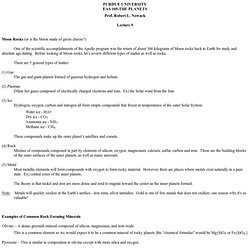

LA FORMATION DE LA LUNE. La théorie la plus rationnelle est celle de l’impact planétaire, aussi appelée collision-éjection.

Cette théorie, formulée en 1975, permet de penser qu’au début de l’histoire de la Terre, il y a 4,6 milliards d’années, alors qu’elle avait à peine fini d’accréter les planétésimaux du nuage protoplanétaire, un astéroïde la percuta violemment. Cet astéroïde constitué de fer, probablement d’une masse comparable à celle de l’actuelle Mars, heurta tangentiellement la Terre.
Sous ce choc, l’axe de la Terre s’inclina d’environ vingt degrés, ce qui fut à l’origine des saisons. D'après ce scénario, une partie importante de l'astéroïde serait restée sur Terre, s'amalgamant au matériau terrestre. En fait, l'astéroïde constituerait un dixième de la masse de la Terre, mais seulement un centième de celle de la Lune. LA FORMATION DE LA LUNE. No Such Thing as Geology on the Moon « bobcat country. In my senior year of high school, Ms.

Moore (the English teacher who taught us T.S. Eliot, Sylvia Plath, Joseph Conrad, and how to write when you aren’t scribbling on an AP Exam booklet) introduced our class to this amazing website… It is the kind of website where you can waste a significant amount of time without feeling guilty because it is so interesting and makes you feel scholarly. Word history rocks.
I used this website tonight to confirm something pertaining to my studies. So today in my geology class… I was actually doing moonology. There’s a first time for everything. This is a basalt magma collected from the moon on the Apollo 17 mission in 1972. This is the same image as above only shown in polarized light. Here is a close up shot of that same plagioclase crystal seen at the center of the image above. Here is a close up of the plagioclase crystal and the lines that develop on its face when in polarized light. Like this: Like Loading... Lecture 9: Moon Rocks and Geology. Prof.

Robert L. Nowack Lecture 9 Moon Rocks (or is the Moon made of green cheese?) One of the scientific accomplishments of the Apollo program was the return of about 300 kilograms of Moon rocks back to Earth for study and absolute age dating. There are 5 general types of matter: (1) Gas The gas and giant planets formed of gaseous hydrogen and helium (2) Plasmas Dilute hot gases composed of electrically charged electrons and ions. . (3) Ice Hydrogen, oxygen, carbon and nitrogen all form simple compounds that freeze at temperatures of the outer Solar System Water ice - H2O Dry ice - CO2 Ammonia ice - NH3 Methane ice - CH4.